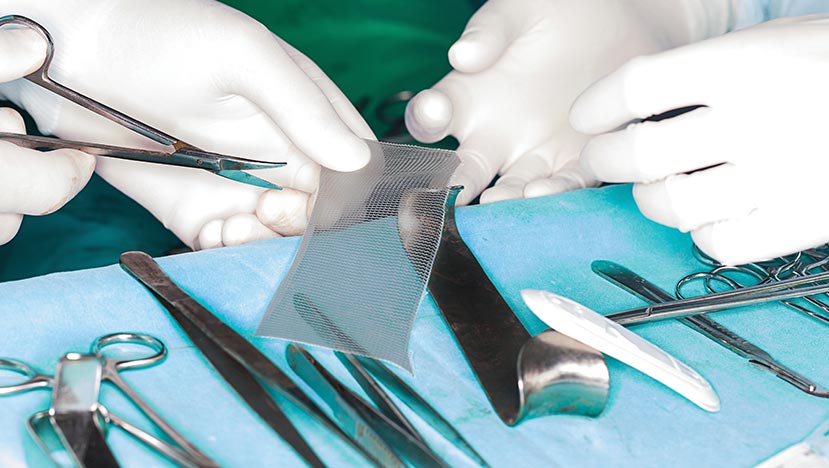
Hernias and Hernia Repair
A hernia is a protrusion of an organ or tissue though an abnormal opening in the body.
Most hernias occur when a piece of intestine slips through a weakness in the abdominal wall, creating a bulge you can see and/or feel.
Hernias can develop around the navel, in the groin, or in any place where you may have had a surgical incision. Some hernias are present at birth; others develop slowly over a period of months or years. Hernias also can appear quite suddenly.
Think of your hernia as a bulge in a tire. The outer wall of the tire is like your abdominal wall, and the inner tube of the tire is like your intestines. Most of the time the outer wall of the tire is strong enough to hold the inner tube, but if the wall weakens a bulge may occur. Similarly, a hernia may form in a weakness in the abdominal wall.
Types of Hernias
Generally, hernias protrude from an opening in the abdominal wall. Types of hernias can include inguinal, umbilical, epigastric, and femoral. These hernias develop when the outer layers of the abdominal wall weaken or tear.
Inguinal hernias are one of the more common types of hernias and can be one of the more problematic ones. Inguinal hernias occur when part of the intestine protrudes or some other soft tissue protrudes through a weak point in your lower abdominal wall. This bulge can occur especially when one bends or tries to lift heavy objects.
In men, these can occur in the area where the spermatic cord passes through the peritoneum into the scrotum.
Symptoms
Symptoms of an inguinal hernia can be brought up quite easily on routine examination. Usually, the patient may feel the bulge. It is more obvious when one stands upright or tries to strain. Pain and discomfort in the groin can be increased from bending over or coughing. Patients with inguinal hernia symptoms may also exhibit a heavy or dragging feeling in the groin. Inguinal hernias are not uncommon even in children; 5 children in 100 have inguinal hernias.
The most common types of hernias are those where the hernia is reducible and cannot be pushed back inside the abdomen. A non-reducible type of hernia sometimes is termed as an incarcerated hernia. These hernias can be extremely problematic when the blood supply is cut off and the tissue swells. The incarcerated hernia can subsequently become strangulated, and the tissue may swell. Once this develops into a strangulated hernia, the tissue can die quickly and become infected. It is for this reason that non-reducible hernias should be treated immediately.
Possible Causes
Risk factors include chronic constipation and excessive weight, which can produce more external pressure on your abdomen, especially for people who work at laborious jobs or require standing for long periods of time.
Diagnosis
Diagnosis depends on where the hernia is and is usually made by clinical evaluation. Some hernias are quite visible and can be felt in the abdominal area or inguinal area quite easily. MRIs or x-rays are not necessary in many cases.
Treatment
Treatment usually includes surgical treatment, especially for hernias that may be strangulated or incarcerated. Surgery is usually done on an outpatient basis. It takes about 20 to 25 minutes and results can be excellent. There are two main types of procedures: The first is called herniorrhapy, which requires the surgeon to push a bulge or protruding intestine back into the abdomen, then repair the torn or weakened muscles. The second procedure is herioplasty. In this procedure, there is actual patching of the hole with some sort of mesh. The patch can be secured with sutures, clips, or staples. Some surgeons have developed an approach called the sutureless technique. These procedures can be done laparoscopically also. The disadvantages of a laparoscopic repair include increased risk of complication or recurrence following surgery.
Post-operatively, to minimize the chances of recurrence, it is usually good to maintain a healthy weight, eat high-fiber foods, stop smoking to lessen the chance of coughing, and minimize heavy lifting.
One of the newer types of mesh treatment is the tension-free treatment, which is done without sutures. In this procedure, there is an incision made at the site of the hernia and a small piece of mesh is inserted to cover the area of the defect without suturing together the surrounding muscles. Recovery can be quite good and the mesh is usually well tolerated by the body’s immune response. The procedure can be done under local anesthetic where the patient is totally awake. Patients are recommended to avoid sexual activity for the first several weeks at a minimum after surgery. The recurrence rate is extremely small and well under 0.25%.
Hernia Repair in Orange County, San Bernardino, Riverside and Los Angeles County:
- Hernia Repair in and near Anaheim
- Hernia Repair in and near Colton
- Hernia Repair in and near Corona
- Hernia Repair in and near Garden Grove
- Hernia Repair in and near Irwindale
- Hernia Repair in and near La Mirada
- Hernia Repair in and near Long Beach
- Hernia Repair in and near Los Angeles
- Hernia Repair in and near Ontario
- Hernia Repair in and near Perris
- Hernia Repair in and near Temecula
Contact Healthpointe Today!
Healthpointe offers comprehensive evaluations and treatments for all your hernia and related needs. To talk to one of our doctors, please schedule an appointment today!
